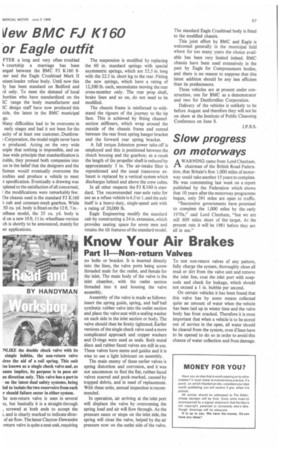Ilew BMC FJ K160 or Eagle outfit
Page 59

If you've noticed an error in this article please click here to report it so we can fix it.
FTER a long and very often troubled L courtship a marriage has been anged between the BMC FJ K160 8ner and the Eagle Crushload Mark II istant-loader refuse body. Until now this iy has been standard on Bedford and rd only. To meet the demand of local horities who have standardized on the IC range the body manufacturer and IC design staff have now produced this tide, the latest in the BMC municipal ige.
Ylany difficulties had to be overcome in early stages and had it not been for the acity of at least one customer, Dunferm: Corporation, the model might never have :n produced. Acting on the very wide iciple that nothing is impossible, and on less wide principle that standardization is irable, they pressed both companies into on in the belief that the designers and the ftsmen would eventually overcome the iculties and produce a vehicle to meet r specification. Eventually a drawing was wleted to the satisfaction of all concerned, 1 the modifications were remarkably few. Ile chassis used is the standard FJ K160 cab and constant-mesh gearbox. While 50 cu. yd. body is fitted on the 12 ft. 7 in.:elbase model, the 35 cu. yd. body is :d on a new 10 ft. 11 in.-wheelbase version ch is shortly to be announced, mainly for rer applications. The suspension is modified by replacing the 60 in. standard springs with special asymmetric springs, which are 52.5 in. long with the 22.5 in. short leg to the rear. Fitting the new springs, which have a rating of 12,300 lb. each, necessitates moving the rear cross-member only. The rear prop shaft, brake lines and so on, do not need to be modified.
The chassis frame is reinforced to withstand the rigours of the journey to the tip face. This is achieved by fitting channelsection stiffeners, which wrap around the outside of the chassis frame and extend between the rear front spring hanger bracket and the forward rear spring bracket.
A full torque Johnston power take-off is employed and this is positioned between the clutch housing and the gearbox; as a result the length of the propeller shaft is reduced by approximately 3 in. The air-intake filter is repositioned and the usual transverse exhaust is replaced by a vertical system which discharges behind and above the crew cabin.
In all other respects the FJ K160 is standard. The recommended rear-axle ratio for use as a refuse vehicle is 6.5 to 1, and the axle itself is a heavy-duty, single-speed unit with a rating of 20,000 lb.
Eagle Engineering modify the standard cab by constructing a 24 in. extension, which provides seating space for seven men and retains the tilt features of the standard model. The standard Eagle Crushload body is fitted to the modified chassis.
This joint effort by BMC and Eagle is welcomed generally in the municipal field where for too many years the choice available has been very limited indeed. BMC chassis have been used extensively in the past by Eagle for Compressmore bodies, and there is no reason to suppose that this latest addition should be any less efficient than its predecessors.
Three vehicles are at present under construction, one for BMC as a demonstrator and two for Dunferinline Corporation.
Delivery of the vehicles is unlikely to be before August and therefore they will not be on show at the Institute of Public Cleansing Conference on June 8.
J.P.B.S.








































































































































































